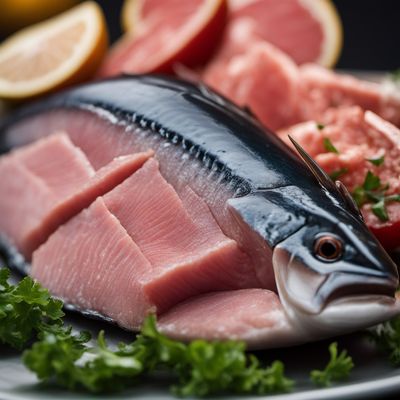
Ingredient
Tuna
The Ocean's Delicacy: Tuna
Tuna is a large, migratory fish found in warm waters. It has a firm, meaty texture and a rich, savory flavor. The flesh ranges in color from light pink to deep red, depending on the species and diet of the fish. Tuna is commonly used in sushi, sashimi, and grilled preparations.
Origins and history
Tuna has been consumed by humans for thousands of years and holds cultural significance in many coastal communities. It is particularly revered in Japanese cuisine, where it is a staple ingredient in sushi and sashimi. Tuna fishing has a long history, with traditional methods evolving into modern commercial practices.
Nutritional information
Tuna is a nutrient-dense fish that is an excellent source of high-quality protein. It is also rich in omega-3 fatty acids, which are beneficial for heart health. Additionally, tuna provides essential vitamins and minerals, including vitamin D, vitamin B12, and selenium.
Allergens
Tuna is a type of fish, and individuals with fish allergies should avoid consuming it.
How to select
When selecting fresh tuna, look for firm, shiny flesh with no discoloration or strong odor. The eyes should be clear and bright. If purchasing tuna steaks, choose cuts that are evenly thick and have a vibrant color. If buying canned tuna, check the expiration date and opt for brands that use sustainable fishing practices.
Storage recommendations
To maintain the freshness of fresh tuna, store it in the refrigerator at a temperature below 40°F (4°C). If purchased whole, gut and clean the fish before storing. If buying tuna steaks, wrap them tightly in plastic wrap or place them in an airtight container. Consume within 1-2 days for optimal quality. Canned tuna should be stored in a cool, dry place and consumed before the expiration date.
How to produce
Tuna is primarily caught in the wild, but it can also be farmed in some regions. However, wild-caught tuna is generally considered to have superior flavor and texture. Tuna fishing requires specialized equipment and knowledge, making it challenging for amateurs to produce at home.
Preparation tips
Tuna can be prepared in various ways, depending on personal preference and the desired outcome. It can be grilled, seared, or baked for a delicious main course. For raw preparations like sushi or sashimi, ensure that the fish is of the highest quality and handled with proper food safety practices. Tuna also pairs well with citrus, soy sauce, ginger, and sesame oil, adding depth and flavor to dishes.
Substitutions
Salmon can be used as a substitute for tuna in many recipes, as it has a similar meaty texture and rich flavor. Other alternatives include swordfish, mahi-mahi, or mackerel, depending on the specific dish or cuisine.
Culinary uses
Tuna is widely used in various cuisines around the world. It is a key ingredient in Japanese sushi and sashimi, as well as Mediterranean dishes like Niçoise salad and grilled tuna steaks. Tuna can also be canned and used in sandwiches, salads, and pasta dishes.
Availability
Tuna is commonly available in coastal regions and countries with access to the ocean. It is particularly abundant in the Pacific Ocean, the Mediterranean Sea, and the Indian Ocean. Canned tuna is widely available in grocery stores and supermarkets worldwide.
More ingredients from this category

Tuna, longtail
The Ocean's Swift Hunter

Tuna, skipjack
The Ocean's Bounty

Tuna, yellowfin
"The Jewel of the Sea: Exploring the Delights of Yellowfin Tuna"

Tuna, bigeye
The Mighty Bigeye Tuna

Tuna, bluefin (generic)
The Jewel of the Sea: Exploring the World of Bluefin Tuna

Bullet tuna
The Speedy Predator

Albacore
The Mighty Albacore

Tuna, blackfin
The Ocean's Delicacy: Exploring the Richness of Blackfin Tuna
Recipes using Tuna

Kinilaw: A Refreshing Filipino Seafood Salad
Tropical Delight: A Burst of Freshness in Every Bite

Ensalada Sevillana with a Twist
Andalusian Delight: A Refreshing Twist on Ensalada Sevillana

Nasi Dagang with Spicy Coconut Fish Curry
Flavors of Asia: Nasi Dagang with a Spicy Coconut Fish Curry

Pizza with Tuna and Onion
Mediterranean Delight: Tuna and Onion Pizza

Nasi Kuning with Fragrant Chicken Curry
Golden Rice Delight: Fragrant Chicken Curry with Indonesian Flair

Baltic-style Tuna Gimbap
Oceanic Delight: Baltic-style Tuna Gimbap